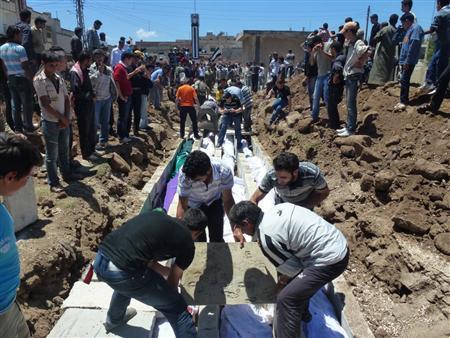(Reuters) – Tattooed youths with AK-47s descend from hilltops onto villages pounded by Syrian artillery and break into homes, slit the throats of women and children or hack them to death. They leave, sometimes carrying bodies to hide traces of the massacre.

Accounts like this from witnesses and opposition campaigners are heard with mounting frequency in north and central Syria, centers of the 15-month revolt against President Bashar al-Assad.
Invariably, activists blame the feared “shabbiha” militia, the most ruthless opponents of the uprising.
The Syrian Network for Human Rights, an opposition group documenting Assad’s crackdown on the revolt, said shabbiha militiamen entered the tiny Sunni Muslim village of Mazraat al-Qubeir on Wednesday after tanks shelled houses and phone lines were cut.
They killed at least 78 civilians and took away 37 bodies, according to the organization.
Security forces bussed in the shabbiha from nearby Alawite villages, it said, the same pattern that was seen in the Sunni Muslim town of Houla two weeks ago and – on a lesser but no less gruesome scale – on the outskirts of Homs, Syria’s third largest city.
Syrian authorities have blamed foreign-backed Islamist “terrorist groups” for the killings.
From humble beginnings as a smuggling and blackmail racket set up by Assad’s relatives in the coastal city of Latakia, the shabbiha have grown into feared militia death squads blamed for the worst atrocities in the revolt.
The protests, now coupled with an armed insurgency against 42 years of family rule by Assad and his late father, pit the ruling elite, from the country’s minority Alawite sect, an off shoot of Shi’ite Islam, against the Sunni-led protest movement.
As Assad increasingly turned to his relatives to strengthen his grip on the majority Sunni Muslim country after inheriting power in 2000, the shabbiha began appearing in Latakia and the nearby Alawite Mountains.
GHOST CARS
Cousins of Assad drove blacked-out Mercedes S class cars, nicknamed “shabbah” or ghosts, with an arsenal of rifles aboard, forcing their way aggressively through the traffic. The name caught on and was adopted by the gunmen to describe themselves as they expanded their racket.
They swiftly developed with state support into a fully-fledged militia after the uprising. Directed by the security forces or ruling Baath Party officials, they put down demonstrations in cities across the country, often by killing demonstrators with live bullets.
At pro-government rallies in Damascus and other cities earlier this year, shabbiha members carried banners that read: “Assad: We are your shabbiha forever,” and “Assad: your name is etched on our AK-47s.”
At the beginning of the revolt, security forces recruited thousands of Sunni Muslims to reinforce the shabbiha’s Alawite core, especially after Assad released thousands from jail in a general amnesty last year.
The shabbiha, however, have became more dependent on recruitment from the Alawite community as the revolt became more militarized and rebels began targeting Assad’s forces, according to opposition sources and diplomats following the uprising.
The massacres – and the increasing risk of being assassinated by rebels – have also put off many Sunnis, although their pay at one point reached $100 a day, a fortune in a country where average salaries are $200 to $300 a month.
“The shabbiha have become a localized Alawite militia present mostly in mixed areas. Their mission is to terrorize the civilian population and conduct ethnic cleansing,” said a diplomat.
Activists say the drive to recruit, arm and train shabbiha from the Alawite villages, many as young as 15 years old, increased as more Sunnis abandoned the militia.
IMPUNITY
“The shabbiha are driven by a feeling of impunity – that they can kill as many Sunnis as they can while Russia’s support for the regime removes any possibility of international intervention,” said Fawaz Tello, a veteran opposition activist who fled Syria last year.
But the militia is taking hits. Lack of Sunni support has all but forced the shabbiha out of the city of Deir al-Zor, where they were instrumental in putting down demonstrations against Assad last year.
“The shabbiha have become nearly extinct in Deir al-Zor. They have dwindled from several thousands to a few hundred,” said Abu Qahtan, an opposition activist in the city.
“Even the criminal elements among them have switched sides and the nature of the tribal society in Deir al-Zor did not allow killings by regime forces to go unpunished without serious retribution,” he added
The activist, who was not using his real name for fear of arrest, said the Alawite core of the shabbiha forces was “imbued with an ideology that killing Sunnis corrects a historic wrong”, namely the marginalization of the Alawite minority.
“The Alawites, in a way, were mostly at the lower end of the social ladder in Syria, but that has not been true since they took over power five decades ago and I am not sure what wrong the present Sunnis did to the Alawites.”
In Damascus, residents and activists said the proportion of Sunnis in the shabbiha had dwindled after 11 shabbiha were assassinated in the staunchly conservative Sunni Damascus district of Maidan during the past two months.
“Even Sunni shabbiha are sometimes being liquidated by Alawite shabbiha because they deem them not trustworthy,” said Damascus-based activist Raed al-Shami.
“You don’t find Damascenes but you still find Sunnis in the shabbiha, especially criminals released last year,” he said, adding that most Alawite shabbiha recruitment in Damascus came from the hilltop Alawite neighborhoods of Qudsaya, Sitta Watmanin, Mezze Jabal and Ish al-Warwar.
In the Sunni Muslim city of Hama, just 20 km (12 miles) east of the location where activists reported a massacre on Wednesday, a potent force of about 3,000 shabbiha remain in position.
“The shabbiha in Hama city are from the Alawite villages around. There is one Sunni village, Qahtaneh, that is all shabbiha, because they follow a general in the security apparatus who runs a smuggling racket with the blessing of the regime,” said activist Raed Farhoud.
(Editing by Giles Elgood)





